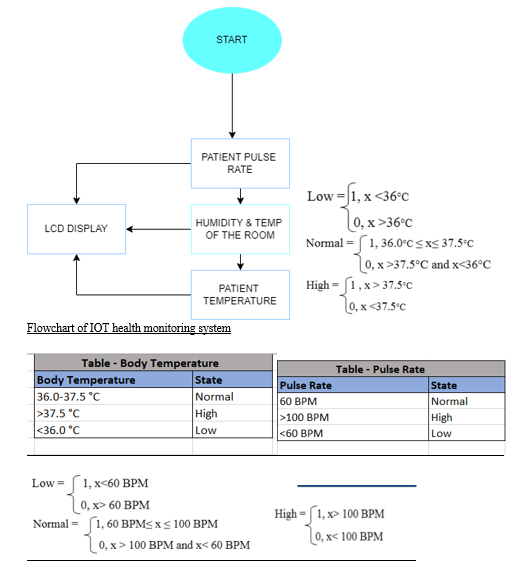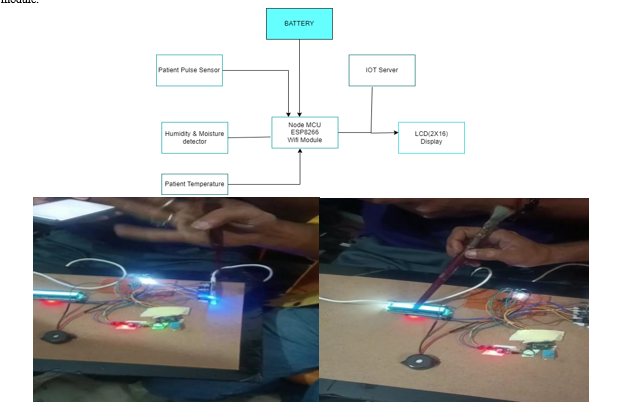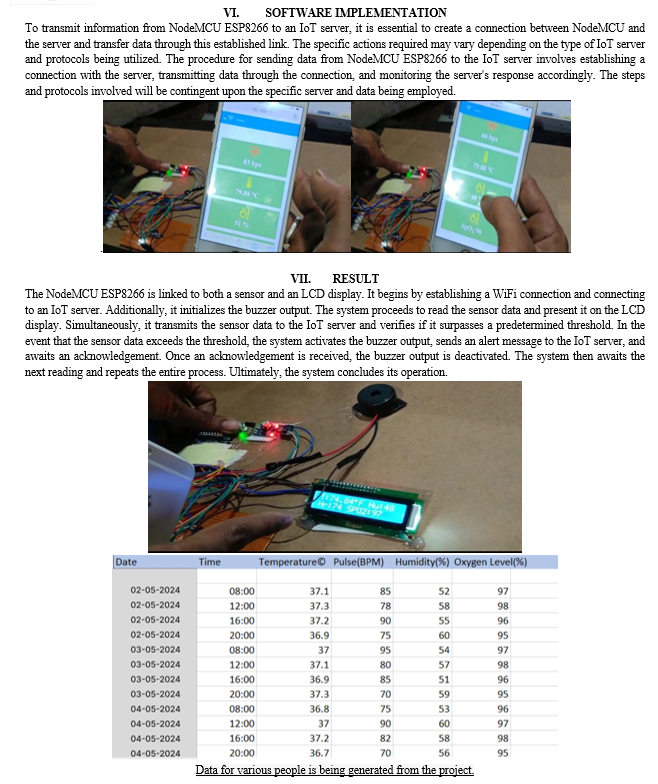Ijraset Journal For Research in Applied Science and Engineering Technology
- Home / Ijraset
- On This Page
- Abstract
- Introduction
- Conclusion
- References
- Copyright
IOT Based Health Monitoring System Using FPGA
Authors: Unnati Mehta, Arjun Garg, Aniket Rana, David Chaudhary, Akshita Singh
DOI Link: https://doi.org/10.22214/ijraset.2024.62356
Certificate: View Certificate
Abstract
Health is a great concern to everyone in the world today. The research was made to develop an effective system of monitoring a person’s health. This is, the body temperature and the heart rate of a person are considered. They also calculated continuously in order to monitor the patient’s data and also the body. The aim of this proposed system is to monitor the patient’s body temperature and heart rate. For instance, the pulse sensor is used in the system to measure the heart rate and Temperature sensor sense temperature and also using ADC the serial data is continuously transmitted by transmitter module fixed to transferring module in the receiver part it is just like LCD is displayed at the patient place other devices available in a laptop, desktop or cell phone with a constant connection. The receiver can either be near the doctors or the patients. The data is stored and can be accessed on a user interface displayed on a PC or a laptop using an IP address. A server receives data from a transmitter units placed close to the patient, sends it through FPGA and receives it from Wi-Fi module attached to it. The proposed programme monitors the patient’s data and displays it continuously while at the same time updating the server. The IP address can be used to check the current health status of the patient. The system as described above give the user’s a reliable, affordable, and easy-to-use remote sensing system that provides 24-hour data. The purpose of the study is to emphasise the availability of FPGA-based design resources worldwide.
Introduction
I. INTRODUCTION
The lifestyle of individuals is evolving rapidly due to advancements in technology, leading to a noticeable trend towards a more solitary existence. The elderly are increasingly living alone, while patients are experiencing a lack of consistent support from healthcare providers. This monitoring system was designed to be easily accessible from anywhere and user-friendly. It is equipped to monitor temperature and heart rate, utilizing an FPGA for efficient data processing. The patient's health data is transmitted via the internet to the receiving end for real-time monitoring. The server collects all data from the transmitting device, ensuring that the patient's health parameters are securely transferred to the cloud through Internet connectivity as part of the Internet of Things initiative. The program has been configured with parameters that allow users to access information from any location worldwide. By entering the IP address of the designated server, users can determine the patient's temperature and heart rate as all data is transmitted to the receiver. The IOT-based health monitoring system and the SMS-based health monitoring system exhibit distinct differences. In the IOT-based system, patient health information can be accessed by multiple individuals through a website or URL, whereas the GSM-based system allows only one person to view health parameters sent via SMS. Additionally, the IOT system offers the advantage of accessing data through various devices with internet connectivity, such as desktops, laptops, smartphones, and tablets. Although cloud services can also be utilized to analyze this data, this essay will focus solely on local viewing where both transmitter and receiver are on the same network.
II. LITERATURE REVIEW
Numerous studies have been conducted and are ongoing to offer substantial backing for present and future endeavors related to the development of an IoT-based health monitoring system utilizing FPGA technology. Below are the research findings from the papers we have reviewed, all of which are relevant to the project focused on constructing and deploying IoT applications on the FPGA platform :
- FPGA Implementation of the IOT
This study proposes an analytical system that utilizes the Internet of Things (IoT) to facilitate the design of consumer electronics. By leveraging IoT, this analytical system can promptly notify the user if any health-related parameters deviate from the normal range. The collected data is uploaded to the cloud through a mobile application and then processed by a field-programmable gate array (FPGA) analysis system. The FPGA system's computation and processing of the raw data enable the wearable IoT device to display pathological conditions to the patient. The key innovation of this research lies in the development of a fuzzy classifier that enhances the accuracy of identifying illness-related pathological states.
The implementation of IoT with FPGA, as discussed in a research article published in an international journal, delves into the realm of IoT. The connectivity between people and smart devices through the Internet of Things is unprecedented in scale. One of the challenges faced by IoT is the management of the vast amount of data produced by resource-limited smart devices, where connectivity issues can lead to data loss. The author of the study elucidated the concept of Internet of Things by implementing it on an FPGA platform. By utilizing cost-effective FPGA implementations for TCP/IP protocols, control systems, data collection, and other IoT components, the author has garnered significant attention from the scientific community for his work on FPGA platforms. This technology offers a comprehensive, affordable, high-performance, and user-friendly remote sensing and monitoring system that operates continuously. The primary objective of the research is to demonstrate to users how they can access the resources of the FPGA-based design from any location. The article also proposes the idea of optimizing the utilization of currently unused resources for the automated execution of various tasks.
2. Implementation on Industrial Monitoring System using FPGA
In this paper, we have introduced an automated monitoring system for industrial applications that manage various types of sensors including gas sensors, digital sensors, dust sensors like PIR motion sensors, and core controllers in FPGA. These sensors are utilized for monitoring industrial facilities and operate within a voltage range of 4.4 V. This setup enables the establishment of a more robust surveillance system that focuses on area coverage, power consumption, and timely reporting. The system consumes 937 LUT, receives power at 48.11 mW, and experiences a delay of 9.065 ns with QUARTUS II 10.0. The Altera Cyclone board can operate at a maximum voltage of 3.3V and features a 50 MHz input frequency generated by a crystal oscillator. VHDL is employed for encoding the GSM module and ADC. Lastly, users can monitor the system status on an LCD screen and assess performance via their cellular network.
3. A novel IoT-based fuzzy classifier with FPGA-based healthcare diagnosis system
The automation and streamlining of vital medical data identification, tracking, and processing can be efficiently achieved through the use of RFID technology. Each RFID tag or wristband can be embedded with a Unique Identification Number (UIN) that is either manually or automatically programmed. The UIN is safeguarded by a password protection system to ensure maximum security. Upon registration, patients are provided with an RFID wristband to facilitate continuous monitoring throughout their hospital stay. This wristband can also store essential patient details (such as name, patient ID, drug allergies, current medications, blood type, etc.) to alert medical staff of potential risks in real-time. Furthermore, data encoded in an RFID bracelet can be accessed discreetly while patients are asleep, allowing healthcare providers to retrieve information without disturbing them.
III. PROPOSED WORK
The main objective of this project is to develop and implement an intelligent patient health tracking system. Sensors embedded on the patient's body are responsible for detecting body temperature and heartbeat. In addition, two extra sensors placed in the patient's room monitor temperature and humidity levels in the surroundings. These four sensors are connected to a control system that interprets the sensor readings. The data obtained is then transmitted to a base station through an IoT cloud, allowing the doctor to remotely access it from anywhere. By analyzing the temperature, heartbeat, and room sensor data, the doctor can evaluate the patient's condition and take appropriate actions.
- The Arduino controller employs a temperature sensor that is linked to an analog pin. This analog signal is subsequently converted into a digital value through an ADC. The obtained digital data is then utilized to compute the precise temperature in degrees Celsius by applying the following formula: temperature (°C) = [raw ADC value5/4095-(400/1000)](19.5/1000).
- The heart rate sensor operates through photo plethysmography, a method that relies on fluctuations in light intensity to identify alterations in the amount of blood flowing through a specific vascular area of the body. By applying the equation BPM (Beats per Minute) = 60*f, with f representing the pulse frequency, the microcontroller calculates the individual's heart rate.
- A hygrometer, which is commonly referred to as a humidity sensor, is designed to detect variations that impact electrical currents or air temperature. Its main purpose is to accurately perceive, gauge, and communicate information regarding moisture and air temperature. By employing the equation Voltage = (ADC Value/1023.0)*5.0, the voltage is determined. The formula used to calculate relative humidity is percent relative humidity = (voltage-0.958)/0.0307.
- When a patient arrives at the hospital, their physiological indicators are detected by sensors. These indicators are then transformed into electrical signals [8]. The analog electrical signal is subsequently converted into digital data and stored in RFID. The stored digital data is then transmitted to the local server using the Zigbee protocol, which is the suitable protocol for this system.

IV. METHODOLOGY
The aim of this project is to develop an IoT-based health monitoring system using ESP8266 that continuously monitors the patient's health parameters like heart rate and body temperature in real-time. The system utilizes a local area network where a Wi-Fi module creates a hotspot connecting to the patient. The Wi-Fi module needs to be linked to the same network as the person wanting to monitor the patient's status. Once connected, the IP address can be entered into any web browser, displaying the patient's temperature and pulse readings. On the patient's end, an LCD screen shows the temperature and pulse readings, enabling the person nearby to easily monitor the patient's status at any given time. The 3an board's built-in temperature sensor detects the temperature, while a remotely connected pulse sensor measures the heart rate.
Both temperature and pulse values are analog signals that need to be converted into digital form using an ADC. The MCP3202 A/D converter is employed to convert these analog signals into digital form. The A/D converter in the MCP3202 follows a standard SAR architecture. Upon receiving the start bit, a sample is taken on an internal sample/hold capacitor for 1.5 clock cycles beginning on the immediate rising edge of the serial clock. After the testing phase, the input switch of the converter is activated, allowing the device to utilize the stored charge on its internal test and hold capacitor to produce a 12-bit serial computerized output code. The MCP3202 A/D converter can achieve conversion speeds of up to 100 kbps. The converted digital values of temperature and pressure are displayed on an LCD screen located nearby. An external Wi-Fi module is connected to the FPGA using UART communication. The transmitter pin of the FPGA is linked to the receiver pin of the Wi-Fi module. The Wi-Fi module receives serial data from the FPGA and transfers the data packets to the storage unit. Additionally, the Wi-Fi module creates a hotspot for monitoring the patient's heart rate and temperature. The values are updated every 5-7 seconds. In essence, this health monitoring system includes sensors for measuring heart rate and temperature, an ADC for converting analog signals to digital form, an LCD display for showing the patient's temperature and heart rate values, and a Wi-Fi module that creates a hotspot for communication with the patient and sends real-time data to any device with an internet connection. The system utilizes the Simple 3an board and the MCP3202 A/D converter to achieve accurate readings of the patient's vital signs.
The values can be checked by essentially writing the IP address into a browser, making it simple for caregivers to screen the patient's wellbeing remotely.
V. HARDWARE AND ITS IMPLEMENTATION
As mentioned earlier, the heart rate is measured by a pulse sensor, while the temperature is measured by a built-in sensor on board. The pulse sensor is connected externally and has its own independent ADC. The ADC uses a temperature sensor that is located on the board. Additionally, there is an LCD monitor connected to the Spartan board. To establish a connection with the external world, the Esp8266-01 utilizes UART communication[9], with the transmitter pin of the FPGA connected to the reception part of the wifi module.

 ???????
???????
Conclusion
The utilization of a NodeMCU ESP8266, sensor, LCD display, IoT server, buzzer, and battery in an IoT based health monitoring system proves to be a beneficial and efficient method for health data monitoring. This system enables real-time monitoring of sensor data, showcasing it on an LCD display, and transmitting it to an IoT server for further analysis. The buzzer feature notifies the user in case of abnormal readings surpassing a set threshold, while also sending an alert message to the IoT server for prompt medical attention. In essence, this system aids individuals and medical professionals in effectively managing and monitoring health data. It is essential to emphasize that the accuracy and dependability of the system rely on the sensor quality and the IoT server\'s resilience. Hence, it is imperative to opt for high-quality components and conduct thorough calibration and testing procedures before deployment.
References
[1] Ajay Rupani1 , Gajendra Sujediya2 “A Review of FPGA implementation of Internet of Things” volume 4 issue 9 [online] https://www.researchgate.net/profile/Ajay_Rupani/publication/309476860_A_Review_of_FPGA_implementation_of_Internet_of _Things/links/5812024108aeda05f0a56b59/A-Review-of-FPGA-implementation-of-Internet-of-Things.pdf [2] M .Kiruba1 , Dr.M Jagadeeswari [2] “FPGA Implementation of Automatic Industrial Monitoring System” IJRSET volume 5 issue 5 [online] available https://www.ijirset.com/upload/2016/may/292_FPGA.pdf.. [3] Lim Chun Keat, Asral Bahari Jambek, Uda Hashim, “ A Study on real time pulse sensor interface with system-on-chip architecture”, Available: https://ieeexplore.ieee.org/document/7804653. [4] Edgefx.us kits and solutions, https://www.efxkits.us/lm35-temperature-sensor-circuit-working/. [5] Microchip Technology Incorporated, “2.7V Dual Channel 12-Bit A/D Converter with SPI Serial Interface”, Available: http://ww1.microchip.com/downloads/en/DeviceDoc/21034F.pdf. [6] Cisco (2011) The Internet of Things. [Online] .Available: http://share.cisco.com/internet-of-things.html. [7] Manan Mehta, “ESP 8266: A Breakthrough in Wireless Sensor Networks and Internet of Things” Available: http://www.iaeme.com/IJECETissues.asp?JTypeIJECET&VType=6&IType=8. [8] electronicsforu.com, https://electronicsforu.com/resources/learn-electronics/16x2-lcd-pinout-diagram [9] Fang Yi-yuan, Chen Xue-jun, “Design and Simulation of UART Serial Communication Module Based on VHDL”, 3rd International Workshop on Intelligent Systems and Applications, 2011, Wuhan, China
Copyright
Copyright © 2024 Unnati Mehta, Arjun Garg, Aniket Rana, David Chaudhary, Akshita Singh. This is an open access article distributed under the Creative Commons Attribution License, which permits unrestricted use, distribution, and reproduction in any medium, provided the original work is properly cited.

Download Paper
Paper Id : IJRASET62356
Publish Date : 2024-05-19
ISSN : 2321-9653
Publisher Name : IJRASET
DOI Link : Click Here
 Submit Paper Online
Submit Paper Online

